The Tulip is quite a disease tolerant; some common Tulip diseases can affect the soil or your new bulb. It is essential to diagnose and take corrective action to diagnose existing problems to reduce the chance of their growth or diseases in the future. Since their bulbs contain many nutrients, they don’t need fertilizing like other plants.
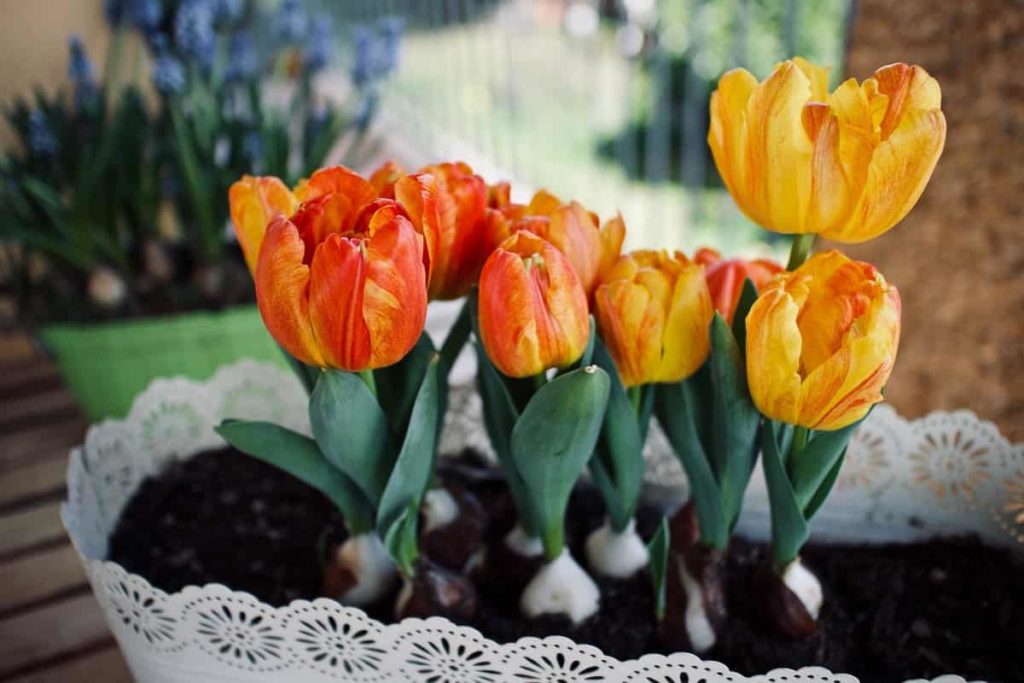
Keep an eye on the pests and take immediate action whenever you find any sign of them. Avoid overwatering, underwater, and overfertilizing to prevent many problems. This will help in the rapid restoration of the plant. Let’s check out 16 common Tulip plant problems below.
16 common Tulip plant problems
Wilted Tulips
Botrytis Blight
Botrytis Blight is a fungal disease that begins with deforming young leaves, causing them to curl and wilt. Leaves often produce white or yellow spots.
Solution – Fungicides can be applied as preventive measures, although they will not help pre-infected plants. Just buy and plant spotless, disease-free bulbs. Remove all weeds from the flowering area, as weeds provide shelter for pests and diseases while restricting good airflow.
Viruses
Viruses cause signs such as streaky, yellow leaves, uneven flower color, and distorted, curled leaves and flowers. Viruses spread through pests such as aphids, thrips, and mites, entering the plant through open cuts. They can also be spread with unclean gardening equipment.
Solution – You cannot cure the Tulip virus; thus, infected plants must be removed and destroyed immediately to prevent infection.
Poor cultural conditions
The Tulips are not particularly water-hungry plants, although they will wilt during drought. Regularly water in dry periods so that soil is constantly moist but not water-logged.
Solution – The Tulips wilt naturally after finishing flowers for the season. Just dig the bulb, remove the leaves, clean the dirt, and store it in a cool, dry spot. Prevention is always better for controlling when it comes to planting health. You should not plant the Tulip at the same location for more than three years.
In case you missed it: How to Prepare the Soil for Tulip Plants: Best Soil Mix, pH, and Compost

Tulip leaves turn red
Stress
Slight discoloration on leaves usually indicates something wrong with the plant. With this in mind, the Tulip is not getting enough heat if you see the leaves turning red. This problem mostly appears in low-temperature areas as it causes flowers not to have enough chlorophyll. As a result, the leaf tips begin to turn red which eventually spreads over all of them.
Solution – Simply shifting the plant to a place where it can get direct sunlight for a long period should be more than enough to prevent this problem. Remember that it will take a few weeks for the flowers to green their leaves, but you should be able to take note of the results in a few days.
Fertilizers
The main problem is that flowers are still not getting enough nutrients. That is why the consumption of fertilizers can be important, as they are the only food sources for your plants.
Solution – Further, fertilizers should be added every 3 to 4 weeks as their effects begin to wear off. Once you take care of it, the color of your leaves automatically returns to green within a few days.
Watering the plants
If you notice that the soil condition around your flowers is very dry, they may need to be watered. Living in a cold area is usually not a problem as moisture in the air is enough to keep the soil moist.
Solution – A proper drainage system avoids such problems while the soil is always moist.
Tulips leaves turn brown
Dehydration often leads to brown leaves in the Tulip plants. If you are not watering the plant properly, start giving them proper water. Other potential problems include poor water quality, high fertilization, improper lighting, poor air circulation, root rot, and pest attacks.
Improper watering
Proper watering of your Tulips helps in keeping the disease at a distance. If the Tulip does get enough water, it won’t be able to grow properly. If you pour more water your Tulips turn brown.
Solution – The Tulips don’t like to be in the water for long. It is mainly caused by poor drainage soil. This can often lead to excessive water, causing rot in the roots. Create additional space between the roots by making holes so that oxygen can reach inside the soil.
Poor water quality
Poor water quality can also cause brown leaves of the Tulip. High concentrations in tap water contain sodium and chloride that can damage your Tulip. Due to such minerals, the Tulips fail to absorb water and nutrients from the roots and produce brown tips on the Tulip leaves.
Solution – Avoid using tap water and use distilled water instead. You can only use tap water after cleaning it. Boil the tap water until it starts evaporating to clean it. Then, wait until the water cools down. It is ready to water your Tulip when the water reaches average temperatures.
Overfertilization
Overfertilization is a common problem your plant can suffer. Since fertilizer contains large amounts of sodium chloride, salts absorb the water in the soil if the plant is overfertilized, making it difficult for the Tulips to absorb water and nutrients from the roots. The Tulips show signs like brown tips on leaves due to the soil’s loss of water and nutrients.
In case you missed it: Growing Tulips Indoors from Seed in Pots, Containers
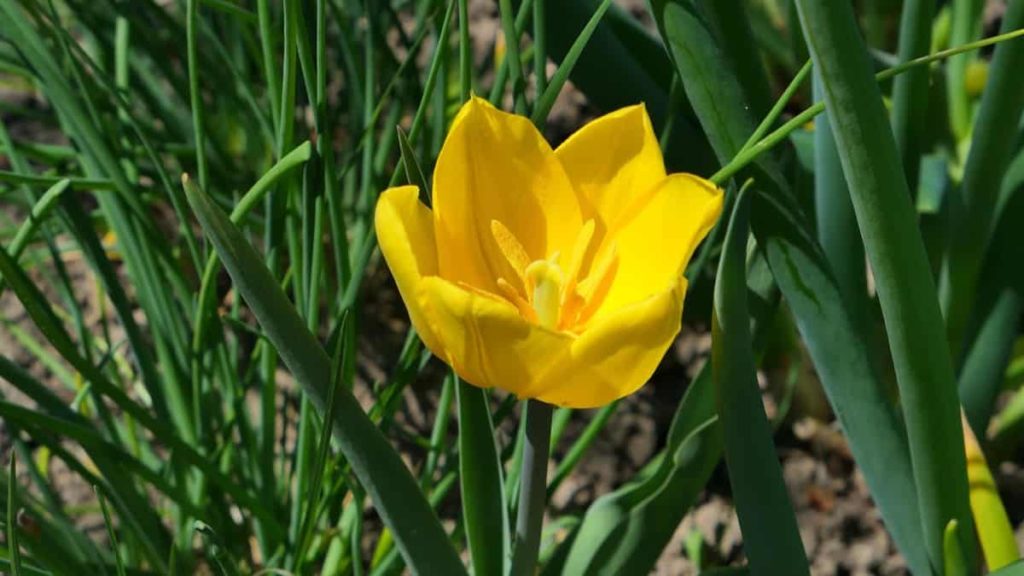
Solution – You should apply a small amount of fertilizer. You can remove excess fertilizer by scratching the top layers of soil. If the situation worsens, transplant your Tulip to a new location with fresh and suitable soil.
Insufficient light
Due to lack of light, the plant will not be able to synthesize the food, and due to lack of energy, the Tulips become weak and show signs like brown leaves. This is why lack of light directly affects the health of a plant and weakens the entire plant.
Solution – If your Tulips are growing at a place where they are not getting enough light, you should transplant them to a new location. Make sure you choose a place where your Tulips get 6 hours of direct sunlight daily.
Poor air circulation
Poor air circulation in the soil can also cause brown leaves on the Tulip. The plant can be stressed due to poor air circulation between the roots. It is mainly caused by poor soil. If the soil structure is heavy, it will make it difficult for plants to breathe properly.
Solution – Soil should contain enough sand to provide air gaps in the roots. To improve the heavy soil texture, you can add organic matter, manure, and compost into the soil. If the soil is too narrow, make small holes to provide airflow to the roots.
Root rot
Root rot is mainly caused by overwater, poor drainage soil, and lack of sunlight. Due to root rot disease, the plant will not absorb nutrients that cause their weakness, and they start showing signs like brown tips on leaves.
Solution – Water your Tulips only when the soil is completely dry. Make sure you add enough sand to the soil to improve drainage. Provide your plant with a full day of direct sunlight to recover them. If the situation is out of control, remove the injured roots and reapply the Tulip to a new location.
Pest attack
Common insects that potentially attack the Tulips are spider mites, bulb mites, aphids, larvae, and slugs. When all these insects eat on leaves, the area turns brown as the leaves lose all nutrients that make the plant completely weak.
Solution – Wash your Tulip using a pipe to eliminate all insects. You can also wash them with insecticidal soap or horticultural oil.
Tulip leaves turning yellow
Seeing your Tulip leaves turning yellow even before the plant’s bloom could signify that you are giving more water. The Tulips perform best where winters are cold, and summer is relatively dry. After planting, water-Tulip bulbs deeply, then do not water them again unless you see the shoots popping in the spring.
Solution – In the absence of rain, about one inch of water per week is sufficient. Similarly, your bulbs can be very wet if you plant them in poorly drained soil. The best drainage is required to avoid the Tulip rotting. You can improve poor soil by adding compost or mulch.
Droopy Tulip plants
Watering Tulips
The main reason for droopy Tulips is dehydration. Although the Tulip does not require much water, it must remain moist. Moreover, if your water these flowers more, it will cause root rot that affects nutrient absorption and can lead to droopy Tulips.
Light and warmth
If you see your Tulip drooping and you know you’re watering them properly, it could be a sign that they’re not getting enough sunlight.
In case you missed it: 18 Common Rose Plant Problems: How to Fix Them, Solutions, and Treatment
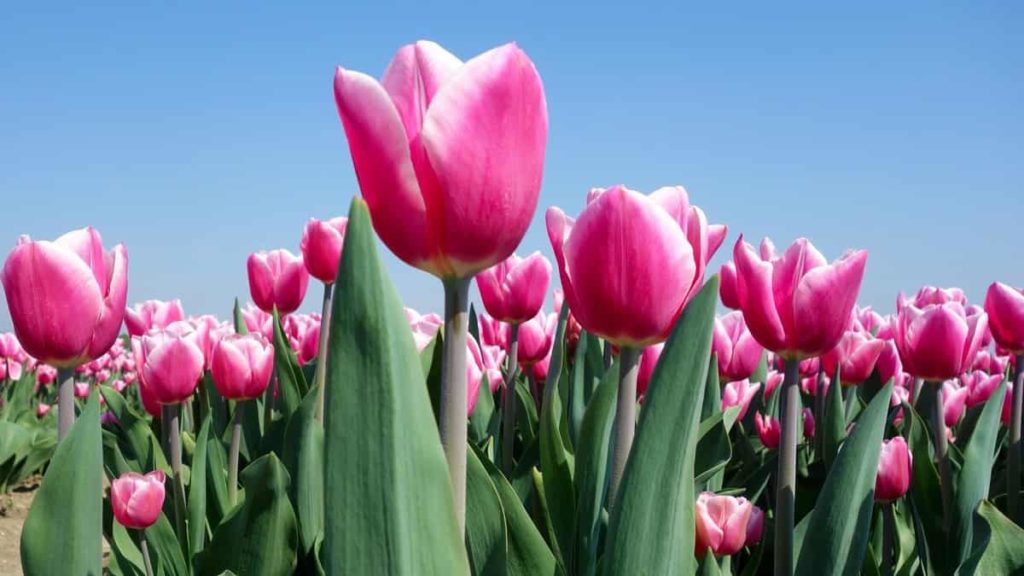
Nutrition
Lack of soil fertility can also cause droopy Tulips, and although the Tulip bulbs are full of nutrients, a little boost from fertilizer can help. Fertilizer will also encourage your bulbs to store more nutrients and potentially help flowers in the future.
Pests and diseases
Another reason for droopy Tulips is the infections of pests and fungi. The Tulip will lose its energy while being affected by its drooping shape.
Solution – If you have decided to cut your Tulips and put them in bouquets, you can take many steps to prevent them from bending. Trimming the stem 3 to 5 centimeters will prevent them from drooping. You can fertilize your Tulip before the leaves are yellow for the best help. It is important to ensure that your Tulip is planted at a point that gets enough light and that there is no barrier to tall trees or buildings.
Water-soaked spots on Tulip leaves
The garden soil or soil mixes poorly in calcium. Sometimes the stems of Tulip flowers fall, and glassy spots appear on the trunks and leaves.
Solution – Remedy the soil by adding ground limestone or spray growing plants with a 2% calcium nitrate solution. Avoid overwater and sudden temperature changes when growing indoors.
Flower stalks are short
Solution – Plant bulbs in the coolest area of your garden. Mulch after freezing the soil in a cold climate. Apply fewer cold varieties and mulch when winter temperature reaches a hot climate.
Dying Tulip plants
Shallow plantation
Solution – After proper depth, the bulbs are protected from sudden climate changes such as extreme hot climate, strong winds, heavy rains, hail storms, or dry weather. Even if the bulbs are planted properly, they will dig insects like rabbits and rats and bring them to a shallow place. That’s why you need to apply them quite deeply. But not too deep. You can also build fences around your Tulip bed.
Pests and diseases
Pests such as aphids, spider and bulb mites, snails, and slugs are common pests found in the Tulip. They will feed the juice of leaves and plants and kill them before their natural death.
Solution – Once they are in your Tulip, they won’t take much time to kill your plant. They are very attracted to moist, warm, and humid conditions. The best solution is to prevent them by using pesticides.
Poor drainage system
Poor drainage will moisten the soil bed for a long time which can cause root and bulb rot. In soggy conditions, the leaves will turn yellow prematurely.
Solution – The only way to save the plant is through daily checking, quick treatment, and prevention. To avoid a long moist soil bed, you can add a layer of mulch or manure to the soil bed.
Overwater
Solution – The Tulips require 1 inch of water only once a week. You can water if the top inches of the soil bed dry.
Lack of proper sunlight
The Tulips will require full sunlight for the healthy growth of leaves and flowers and prominent colors. Insufficient amounts of sunlight will affect the perception of the Tulip. The plant will not grow well, it may take a long time for the soil to dry, and the flowers will not appear as per your expectations.
In case you missed it: Growth Stages of Flowering Plants: Rose, Marigold, Hibiscus, Dahlia, Gerbera Daisy, and Jasmine
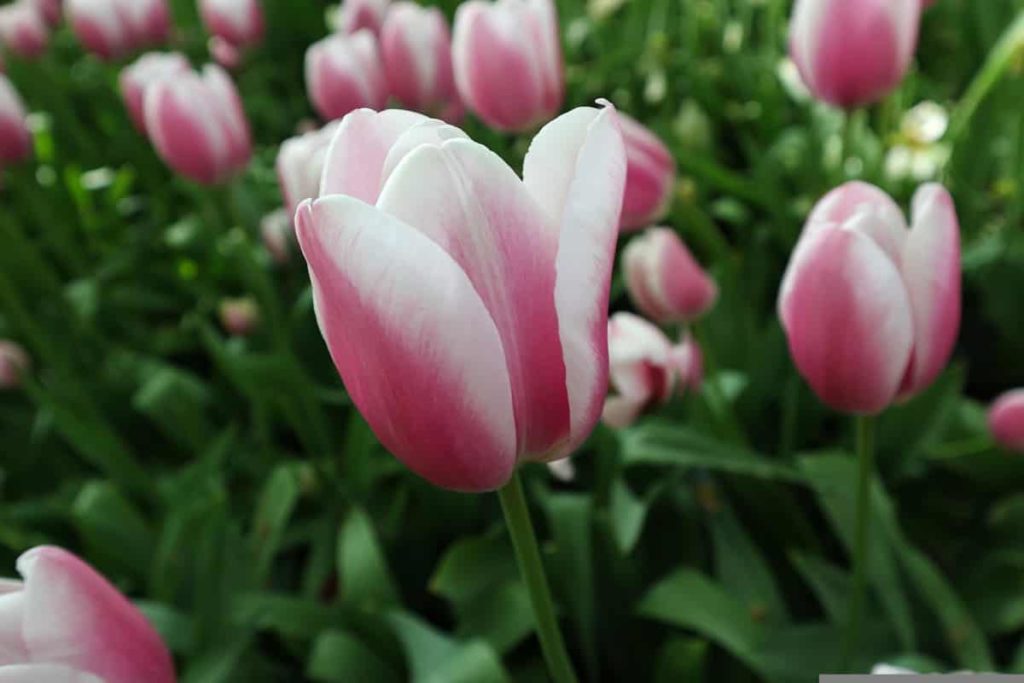
Solution – The leaves will start to become pale and yellow. You must transplant them to a full sunlight site to bring them to life.
Dehydration
To protect the plant from excessive water, do not underwater your Tulip. Just like the Tulip doesn’t like moist soil. Similarly, they will not enjoy the long drought. Once a week, bulbs without proper water will also die due to dehydration.
Solution – You should water Tulip plants when the soil is dry.
Natural death
If you’re an early one in growing the Tulip, you should know that the Tulips bloom during spring, and they will die after a few weeks. The leaves will also start dying a few weeks after the flower dies.
Solution – You don’t have to worry when you find the Tulips dying after the spring bloom. It’s a natural cycle to die, and you can’t bring this condition to life.
The Tulip plant has a lot of leaves but no flower
Poor environmental conditions
Extreme wet conditions can damage bulbs. Too much water can cause the Tulip bulbs to rot. Then, in this case, the bulbs have to be changed.
Solution – Choose a plantation site that drains well and does not collect standing water for your new Tulip bed.
Improper bulb storage
Tulip bulbs may not bloom next spring if the location is not cool enough. This is also acceptable in bulbs that are left in the ground.
Solution – Another problem with indoor storage could be another fruit or ethylene gas source, which can cause flower growth to stop inside the bulb. Ethylene gas exposure sometimes occurs when bulbs are stored near Apples or in Garages.
Bulbs that are not viable
If you buy them second-hand, cut a bulb to ensure the flower is alive; it should look green and fresh. If it looks brown and shriveled, that bulb won’t bloom, although it will probably still keep the leaves out.
Solution – Usually, large, firm Tulip bulbs are generally viable, while small, dry, or wilted bulbs are not.
Inappropriate Tulip leaf care
Once the flowers fade on your Tulip and the leaves start to turn brown, you may be tempted to cut them. If you do, you may prevent the flower from re-blooming next year. It’s okay to cut only the stem after the flower has wilted, but leave the leaves until it dies completely back and loses easily with the bulb.
Diseases
Tulip Fire
A Tulip fire is a fungal disease that affects every part of the Tulip. The leaves are colorless and twisted and appear burnt or scorched. If the flower emerges, it will also be seen. The spots are mold, and eventually, the whole plant rots and falls.
Solution – Once a fungal disease is caught, you can do nothing to treat it. All fungicides are preventive treatments and must be applied before seeing symptoms of the disease.
Bacterial soft rot
You see spots on leaves and stems that look wet or water-soaked. Over time, these spots grow and become soft, sunken, mushy, colorless, and stinky.
Solution – Once rotten, there is no cure. Dig and throw away the bulbs.
Bulb rot
Rotten bulbs will either be firm and chalky with gray, white, or pink mold or soft and mushy texture.
Solution – To prevent bulb rot, buy bulbs only from reputable companies, or avoid them if buying bulbs from nurseries that have mold or abrasions. Also, be careful to avoid nicking bulbs while planting, as this will make them infected.
Remove and destroy any affected plants; do not plant bulbs that look colorless, spongey, or moldy. Bulbs in good condition at the purchase can rot later if stored in damp areas. Also, do not replant the Tulip in the soil where there has been a fungal attack for at least three years.
In case you missed it: Growing Water Lilies – A Full Planting Guide
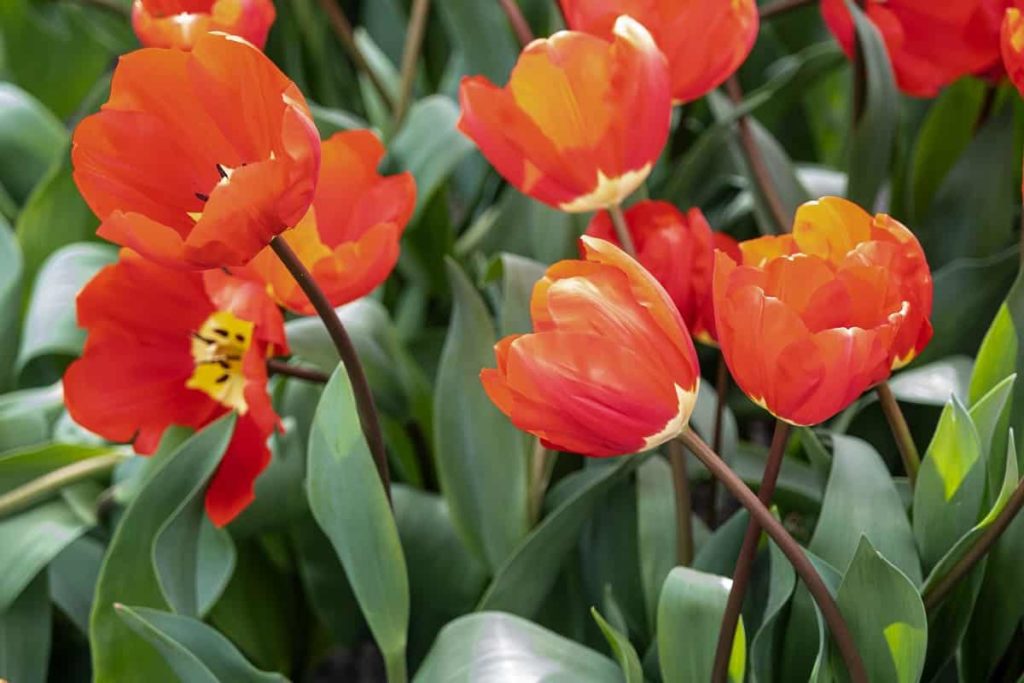
Viruses
Viral infections that affect the Tulip can cause flowers to be spotted, streaked, or mottled and prevent growth. Leaves can also produce white or light green streaks. Plants don’t usually die, but they become severely weak. Aphids can spread viral infections by feeding diseased plants and taking viruses into healthy plants.
Solution – To eliminate viral infections, destroy all affected bulbs and plants, with those who have been close to them. Gardeners who do not want to apply toxic pesticides can naturally control the aphids by using ladybugs, which are hungry hunters of the aphids.
Pests
Aphids
These small, soft body pests hang on the leaf stems and bottoms. They suck the juice from the plant, which causes the color to deteriorate.
Solution – Keep the aphids under control with a hose, a stream of insecticidal soap, or friendly ladybugs.
Spider mites
They suck the juice from leaves. The damage caused by them produces a stained white or yellow shape.
Solution – A good way to tell if you have spider mites is to shake the affected part of the plant on a white paper sheet. Look for small dots if they’re moving; they’re spider mites. Control them with a strong blast with your hose.
Slugs
The slug contains fat, soft boneless bodies and leaves a slimy trail. They eat leaves and sometimes make holes in flowers.
Solution – You can buy a commercial slug trap, put a little beer in a small container, and set it in the garden with a container-level lip with soil. Slugs are attracted to beer.
Conclusion
You should immediately identify the problem to treat your Tulip well. Once you know what your plant is facing, it becomes easier to recover. With an understanding of potential problems and working to make adjustments as needed, you can become a specialist farmer of the Tulip, well-versed and experienced in growing beautiful flowers year after year.
- How to Grow Hibiscus from Flower
- Plantation Ideas for Home Decoration: A Beginners Guide
- Flower Garden Designs and Layouts for Beginners
- Planting and Spacing Techniques in Papaya: A Beginner’s Guide
- Growing Gold: Essential Techniques for Planting Pineapples
- How to Make Kalanchoe Plant Bushy: Home Remedies and Solutions
- 11 Reasons Why Your Gardenia is Not Blooming: Home Remedies and Solutions
- Eco Elegance: The Guide to Designing a Drought-Tolerant Landscape
- Gardening on a Slope: Strategies for Hillside Landscaping
- Nourish and Flourish: Top Organic Mulches for Thriving House Plants
- Everything You Want to Know about Indian Mogra Flower: Discover Uses and Growing
- Green Thumb Success: Expert Tips for Cultivating Greenhouse Pumpkins All Year Round
- Maximize Growth & Flavor: The Ultimate Guide to Companion Planting in Herb Gardens
- How to Control Rhododendron Problems Naturally: Home Remedies and Organic Ways to Fix Them
- Natural Magic: The Remarkable Benefits of Cinnamon for Plants
- Best Steps to Revive Dying Tulip with Natural and Organic Treatment
- 10 Reasons Why Your Angel Trumpet is Not Blooming: Remedies and Treatment
- How to Fix Periwinkle Leaf and Flower-Related Problems: Natural Remedies and Solutions
- How to Fix Zinnias Leaf and Flower Problems: Discover Natural and Home Remedies
- Organic Steps to Induce Lemon Tree Flowers: A Comprehensive Guide
- Bloom Booster: Crafting the Perfect Homemade Bougainvillea Fertilizer
- Optimizing Growth: A Guide to Applying NPK Fertilizer for Potted Plants
- 10 Best Homemade Fertilizers for Rubber Plant: DIY Recipes and Application Method
- How to Boost Female Pumpkin Flowers: Effective Steps for More Flowers and High Yields
- Transform Your Indoor Garden: Top Benefits of Pink Salt for Houseplants
- 10 Best Homemade Fertilizers for Peacock Plants (Calathea): Easy DIY Guide
- Unlock Blooms: 9 Reasons Why Your Potted Chrysanthemum is Not Blooming
- 8 Reasons Why Your Potted Hibiscus is Not Blooming: Fix it with Simple Solutions
- Unlock Blooms: 9 Key Reasons Your Potted Frangipani Won’t Flower
- 10 Reasons Why Is My Ice Plant Not Blooming: Remedies and Treatment
- 10 Reasons Why My Potted Hydrangea Not Blooming: Treatment and Remedies
- 10 Reasons Why is My Wisteria Not Blooming: Remedies and Treatment
- 10 Reasons Why is My Goldfish Plant Not Blooming: Remedies and Treatment
- Maximize Your Space: Ultimate Guide to Balcony Gardening with Grow Bags
- 10 Reasons Why Your Iris is Not Blooming: Remedies and Treatment
- 10 Reasons Why Your Anthurium Plant is Not Blooming: Treatment and Remedies